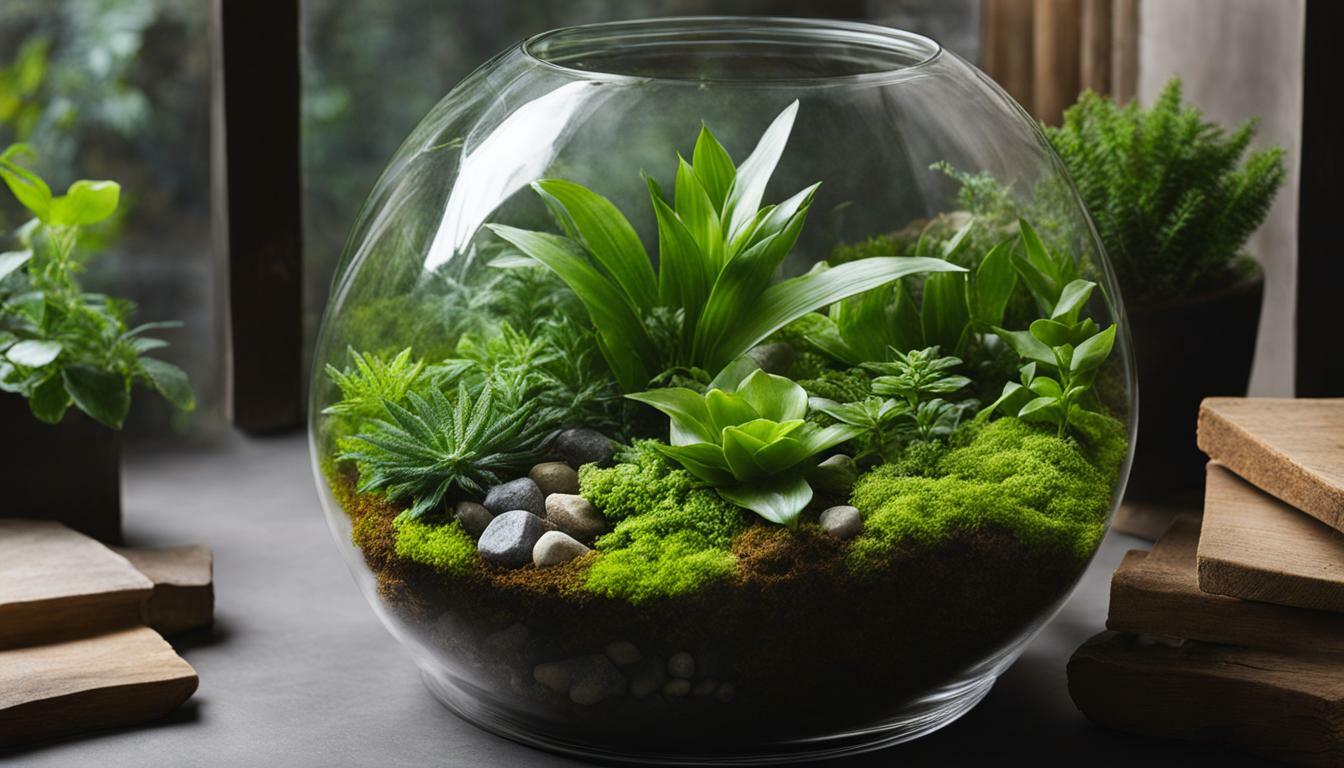Closed terrariums are self-contained mini ecosystems that simulate natural cycles and can be created and maintained in glass containers. These miniature worlds bring the beauty of nature indoors, allowing you to observe and appreciate the wonders of the natural world up close. Closed terrariums are not only visually captivating but also provide a sense of tranquility and relaxation.
Key Takeaways:
- Closed terrariums recreate the natural cycles of the world in a miniature form.
- Glass containers are ideal for closed terrariums as they trap moisture and humidity.
- Options for suitable containers include apothecary jars, spice jars, and fish tanks.
- The key layers in a closed terrarium are the drainage layer, substrate layer, hardscape materials, and selection of appropriate plants.
- When choosing plants, select small plants that thrive in a moist environment and have similar light requirements.
Creating a self-sustaining closed terrarium involves careful considerations such as plant size, terrarium lighting, and the possibility of introducing bioactive bugs and microfauna. To construct a closed terrarium, you will need a clear glass container, drainage materials, substrate, tools, bioactive bugs, plants, and a lid to create the perfect enclosed environment. If you prefer a ready-made option, closed terrariums can be found for sale on platforms like Etsy, or you can purchase a terrarium kit that includes all the necessary materials.
Caring for a closed terrarium requires maintaining a moisture balance by occasionally opening the lid to allow excess water vapor to evaporate. Place the terrarium in a bright spot with indirect sunlight and away from direct heat sources. Regularly remove any dead or yellowed leaves to keep the terrarium clean and thriving. Suitable plants for closed terrariums include moss, ferns, foliage plants, and epiphytes, all of which contribute to the beauty and functionality of the self-sustaining mini ecosystem.
What Are Closed Terrariums and How Do They Work?
Closed terrariums are miniature versions of natural ecosystems, encapsulated within glass containers to recreate the various environmental cycles that sustain life. These self-contained habitats mimic the Earth’s water cycle, where moisture is trapped and released through the process of condensation and evaporation. The closed nature of these terrariums helps to create a humid and moist environment, ideal for supporting the growth of plants and creating a sustainable ecosystem.
When it comes to creating a closed terrarium, the choice of a suitable glass container is crucial. While terrariums don’t have to be completely airtight, they do need to be able to trap moisture and humidity effectively. Glass containers such as apothecary jars, spice jars, and even fish tanks are popular choices, as they provide a transparent and aesthetically pleasing view of the mini ecosystem within.
To understand how closed terrariums work, it’s important to consider the key layers involved in their creation. These layers include the drainage layer, substrate layer, hardscape materials, closed terrarium plants, and personal touches. The drainage layer helps prevent waterlogging by allowing excess water to flow out, while the substrate layer provides the necessary nutrients for the plants to thrive. The hardscape materials, such as pebbles or decorative rocks, add visual interest and help create a natural-looking environment. Finally, the selection of appropriate plants plays a vital role in maintaining the balance of the closed terrarium.
| Key Layers in a Closed Terrarium | Description |
|---|---|
| Drainage Layer | Prevents waterlogging and allows excess water to flow out. |
| Substrate Layer | Provides necessary nutrients for plant growth. |
| Hardscape Materials | Add visual interest and create a natural-looking environment. |
| Closed Terrarium Plants | Selection of suitable plants that can thrive in a closed environment. |
By understanding the components and mechanisms that make closed terrariums work, plant enthusiasts can create their own self-sustaining miniature ecosystems, bringing a slice of nature into their living spaces.
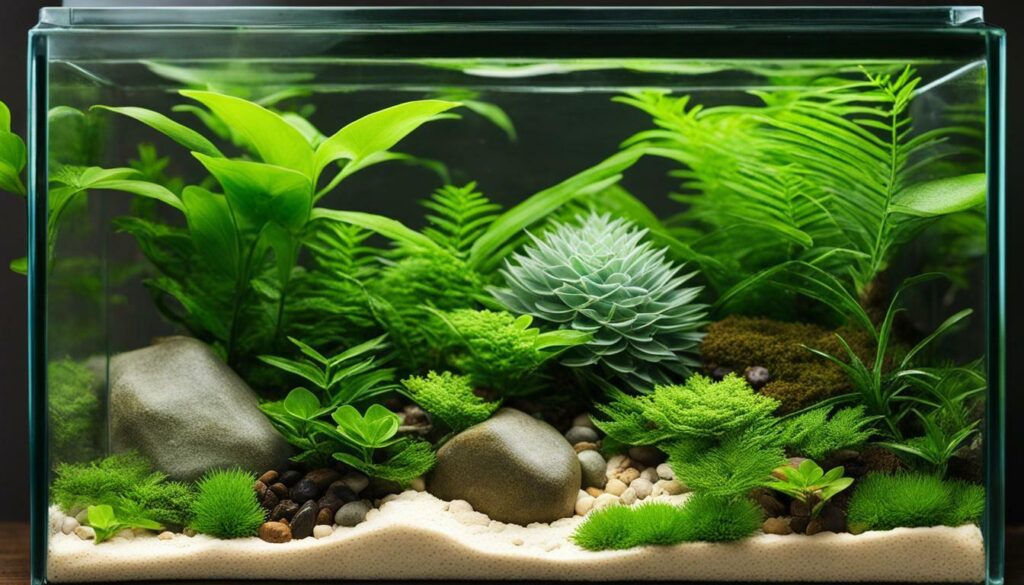
“Closed terrariums provide a unique opportunity to observe the delicate balance of nature within a small, controlled environment.” – Dr. Emily Green, Botanist
Choosing the Right Container for Your Closed Terrarium
The choice of container is crucial for the success of a closed terrarium, and various options, including apothecary jars, spice jars, and even fish tanks, can be used. The container should be made of clear glass to allow sunlight to penetrate and create a conducive environment for the plants inside. Clear glass containers also offer a visually appealing display, allowing you to enjoy the beauty of your mini ecosystem.
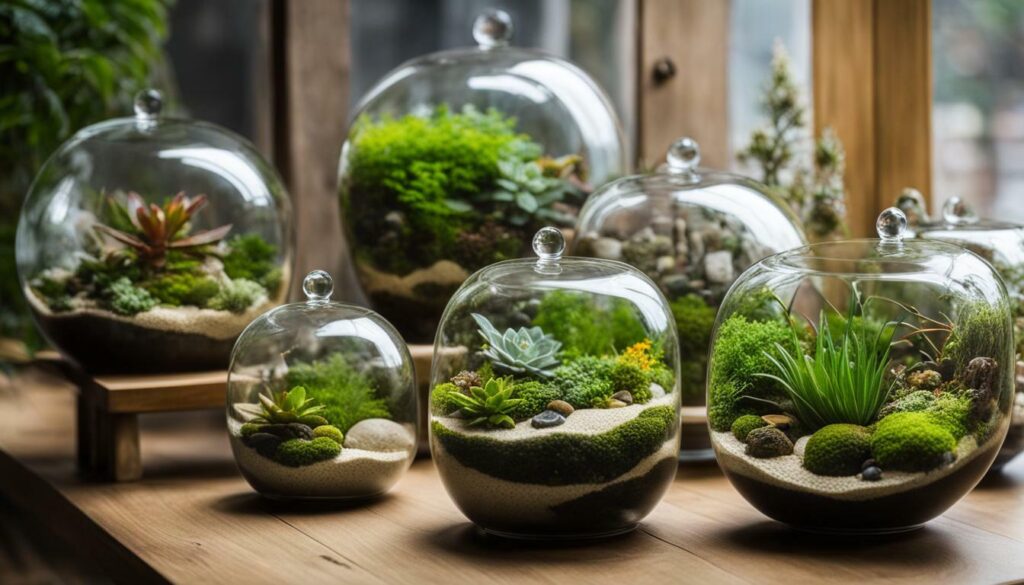
Apothecary jars are a popular choice due to their elegant design and wide openings, making it easy to assemble and maintain the terrarium. Spice jars, on the other hand, are perfect for smaller terrariums or for those looking to create a charming display in tight spaces. Fish tanks, with their larger size and openness, provide ample room for creativity and a larger assortment of plants and decorations.
When selecting a container, ensure that it is deep enough to accommodate the layers needed for a closed terrarium. The depth will depend on the size of the plants you plan to include and the overall design you want to achieve. Remember to consider the available space in your home or office, as larger containers may require more room for display.
| Container Type | Advantages | Disadvantages |
|---|---|---|
| Apothecary Jars | Elegant design, wide openings | Limited size options |
| Spice Jars | Perfect for small spaces | Smaller size limits plant variety |
| Fish Tanks | Large size, room for creativity | Require more space for display |
Things to Consider:
- Container material and transparency
- Size and depth of the container
- Available space for display
Quote:
“The right container not only provides a suitable habitat for your closed terrarium, but it also enhances its overall aesthetic appeal. Choose a container that reflects your personal style and complements the surrounding decor.” – Closed Terrarium Enthusiast
By carefully selecting the right container for your closed terrarium, you can create a captivating display that brings nature indoors. Whether you opt for an apothecary jar, a spice jar, or a fish tank, the choice is yours to make. Embrace your creativity and watch your mini ecosystem thrive in its new home.
Layers in a Closed Terrarium: Creating the Perfect Environment
To create a closed terrarium, it is important to understand the significance of each layer involved in establishing the perfect environment for the plants and ecosystem to thrive. These layers work together to create a self-contained microclimate that mimics the natural cycles of the world. Let’s take a closer look at each layer and its role in maintaining a healthy closed terrarium.
The Drainage Layer
The drainage layer is the foundation of a closed terrarium. It helps prevent waterlogging and root rot by allowing excess water to escape. This layer is typically made of small rocks or pebbles that create spaces for water to flow through. It is essential to ensure proper drainage to avoid water stagnation, which can be detrimental to the health of the plants and the overall ecosystem.
The Substrate Layer
The substrate layer is where the plants’ roots will grow and obtain nutrients. It is typically composed of a mixture of potting soil, sand, and activated charcoal. The potting soil provides essential nutrients, while the sand helps improve drainage. The activated charcoal helps keep the terrarium free from any odors or toxins, maintaining a healthy environment for the plants and microorganisms.
The Hardscape
The hardscape layer is where you can get creative and add personal touches to your closed terrarium. It can include decorative elements such as rocks, pebbles, and driftwood, which not only enhance the visual appeal but also create additional hiding spots for beneficial bugs and microfauna. The hardscape layer adds depth and texture to the terrarium, making it visually captivating.
The Closed Terrarium Plants
No closed terrarium is complete without the addition of suitable plants. These plants should be small in size, as they will be confined to the limited space of the terrarium. Moss, ferns, foliage plants, and epiphytes are excellent choices for closed terrariums, as they thrive in a moist environment and can tolerate low-light conditions. These plants will contribute to the overall aesthetic and function of the terrarium.
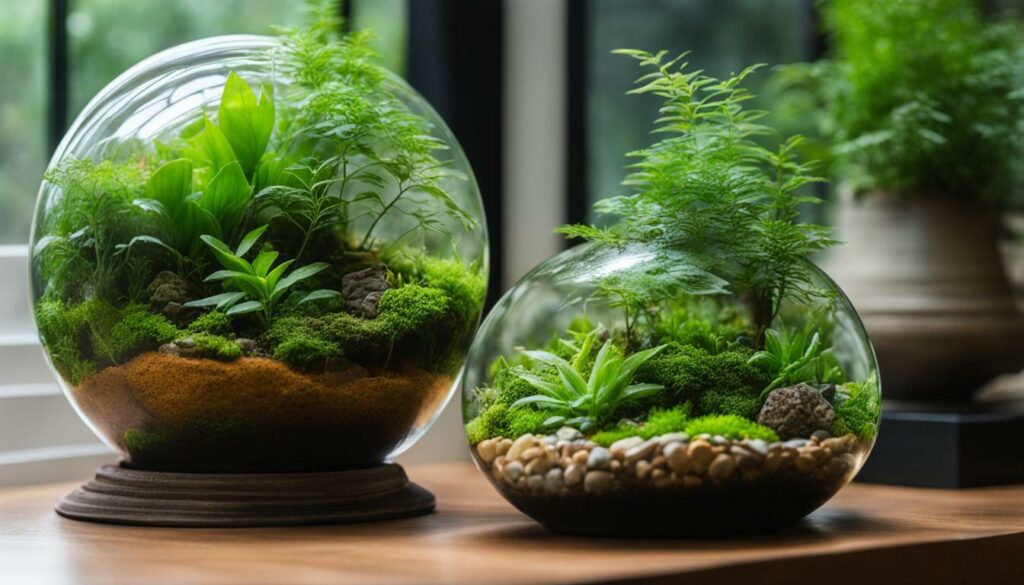
By understanding the significance of each layer in a closed terrarium, you can create an environment that supports the growth and sustainability of a self-contained mini ecosystem. The layers work together to maintain the right balance of moisture, drainage, and nutrients for the plants and microorganisms to thrive. So, whether you’re a beginner or an experienced terrarium enthusiast, remember to pay attention to the layers when building your closed terrarium.
Selecting Plants for Your Closed Terrarium
Selecting the ideal plants for your closed terrarium is crucial for maintaining a healthy and balanced ecosystem, and small, moisture-loving plants with similar light requirements are the best choice. These plants will thrive in the controlled environment of a closed terrarium, creating a lush and captivating miniature world. When choosing plants, keep in mind that they should be able to tolerate high humidity and low air circulation. Here are some suitable options:
| Plant | Light Requirements |
|---|---|
| Moss | Low to medium light |
| Ferns | Medium to bright indirect light |
| Foliage plants | Bright indirect light |
| Epiphytes | Bright indirect light |
Moss is a popular choice for closed terrariums due to its ability to thrive in low light conditions. It adds a beautiful, carpet-like texture to the terrarium and helps retain moisture. Ferns, such as the maidenhair fern or bird’s nest fern, are also great options as they prefer higher humidity levels and can tolerate lower light. Foliage plants like fittonia or peperomia add a splash of color with their vibrant leaves. Epiphytes, such as air plants or bromeliads, are interesting choices that can attach themselves to hardscape materials and don’t require soil.
Remember to consider the size of the plants when selecting them for your closed terrarium. Choose plants that won’t outgrow the container and overpower the other elements. It’s also a good idea to select plants with different textures and leaf shapes to create visual interest within the terrarium.
With the right selection of plants, your closed terrarium will flourish and provide you with a fascinating glimpse into the natural world in a miniature form.
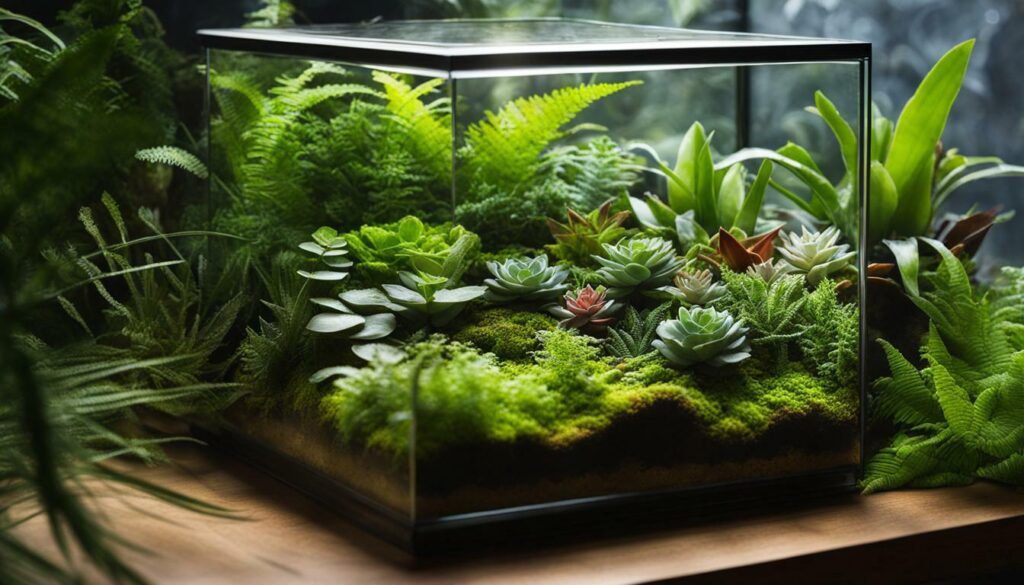
- Avoid using plants that require a lot of direct sunlight, as this can cause excessive heat and damage the delicate ecosystem.
- Consider incorporating tiny figurines or decorative elements to enhance the visual appeal of your closed terrarium.
- Regularly monitor the plants for any signs of overgrowth or leaf decay, and trim or remove them as needed to maintain a balanced environment.
By selecting the right plants and providing them with the proper care, your closed terrarium will become a captivating centerpiece that brings a touch of nature into your home or office.
Building a Self-Sustaining Closed Terrarium
Building a self-sustaining closed terrarium requires careful planning, taking into account factors like the size of the plants, appropriate lighting, and the potential inclusion of beneficial bugs and microfauna. The success of a closed terrarium relies on creating a balanced ecosystem within the glass container, mimicking the natural cycles found in the world.
When selecting plants for your closed terrarium, consider the size of the plants to ensure they can thrive in the limited space. Opt for small plants that won’t outgrow the container or overshadow their neighbors. This helps maintain a harmonious balance within the terrarium ecosystem.
Terrarium lighting is another crucial aspect to consider. Most closed terrariums thrive in bright, indirect light. Avoid placing the terrarium in direct sunlight, as this can cause excessive heat and damage the delicate plants. If necessary, artificial grow lights can be used to supplement natural light and ensure the plants receive adequate illumination.
For those looking to add an extra level of complexity to their closed terrarium, introducing beneficial bioactive bugs and microfauna can create a more dynamic and self-sustaining ecosystem. These organisms, such as springtails or isopods, help break down decaying matter and recycle nutrients, contributing to the overall health of the terrarium.
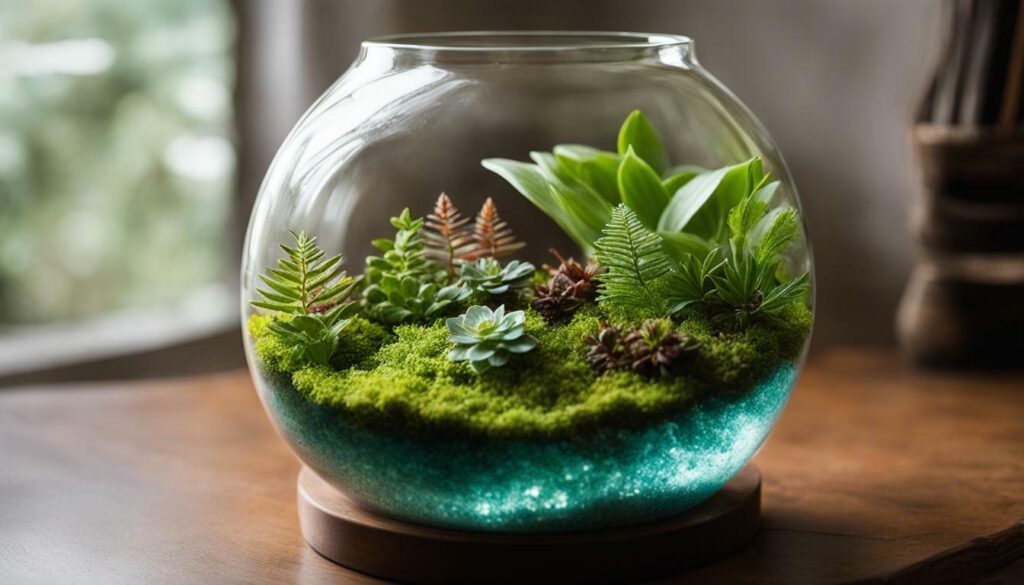
| Factors to Consider | Tips |
|---|---|
| Plant Size | Choose small plants that fit the container and won’t overcrowd the terrarium. |
| Terrarium Lighting | Place the terrarium in a bright spot with indirect sunlight or use artificial grow lights if needed. |
| Bioactive Bugs and Microfauna | Consider introducing beneficial organisms like springtails or isopods to aid in nutrient recycling. |
Creating a self-sustaining closed terrarium is like building a tiny ecosystem in a glass container. By carefully selecting the right plants, providing appropriate lighting, and potentially adding bioactive bugs, you can create a captivating miniature world that thrives on its own.
Explore the table above for quick reference:
- Plant Size: Choose small plants that fit the container and won’t overcrowd the terrarium.
- Terrarium Lighting: Place the terrarium in a bright spot with indirect sunlight or use artificial grow lights if needed.
- Bioactive Bugs and Microfauna: Consider introducing beneficial organisms like springtails or isopods to aid in nutrient recycling.
Building a self-sustaining closed terrarium allows you to create a captivating and low-maintenance piece of nature that can thrive for years to come. With careful planning and attention to detail, your closed terrarium can become a living work of art that brings the beauty of the natural world into your home.
Necessary Supplies for a Closed Terrarium
To successfully create a closed terrarium, you will need a range of supplies, including a suitable glass container, appropriate drainage materials, substrate, essential tools, carefully selected plants, bioactive bugs, and a secure lid. Let’s take a closer look at each of these supplies and why they are important in creating a thriving mini ecosystem.
Glass Container
A clear glass container is essential for a closed terrarium as it allows for easy observation of the plants and ecosystem inside. Choose a container that is transparent and large enough to accommodate the plants and hardscaping materials you plan to use. Popular options include apothecary jars, spice jars, and fish tanks. The glass container should have a wide opening for easy access and maintenance.
Drainage Materials and Substrate
Proper drainage is crucial in a closed terrarium to prevent waterlogging and root rot. Add a layer of small pebbles or activated charcoal at the bottom of the container to create a drainage layer. This will help excess water to drain away from the plant roots. On top of the drainage layer, add a substrate made of a mixture of potting soil and sand or peat moss. The substrate provides nutrients and stability for the plants.
Essential Tools
Having the right tools will make the process of creating and maintaining a closed terrarium much easier. Some essential tools include small gardening scissors or pruning shears for trimming plants, long tweezers for placing plants and hardscaping materials, and a spray bottle for misting the terrarium. These tools will help you create and maintain a well-groomed and healthy mini ecosystem.
Carefully Selected Plants, Bioactive Bugs, and a Secure Lid
When choosing plants for your closed terrarium, opt for varieties that can thrive in a moist and humid environment with similar light requirements. Moss, ferns, foliage plants, and epiphytes are all well-suited for closed terrariums. You may also consider introducing bioactive bugs such as springtails or isopods to help with decomposition and nutrient recycling. Finally, ensure your terrarium has a secure lid that can trap moisture and humidity while allowing for occasional airflow to maintain a healthy balance.
| Supplies | Description |
|---|---|
| Glass Container | A transparent and suitable container for housing the plants and ecosystem. |
| Drainage Materials and Substrate | Pebbles or activated charcoal for drainage, and potting soil mixed with sand or peat moss for the substrate. |
| Essential Tools | Gardening scissors, tweezers, and a spray bottle for easy maintenance. |
| Carefully Selected Plants, Bioactive Bugs, and a Secure Lid | Plants that thrive in a moist environment, beneficial bugs for decomposition, and a lid to trap moisture and humidity. |
By gathering these necessary supplies, you will be well-equipped to create a beautiful and self-sustaining closed terrarium that brings the wonders of nature into your home.
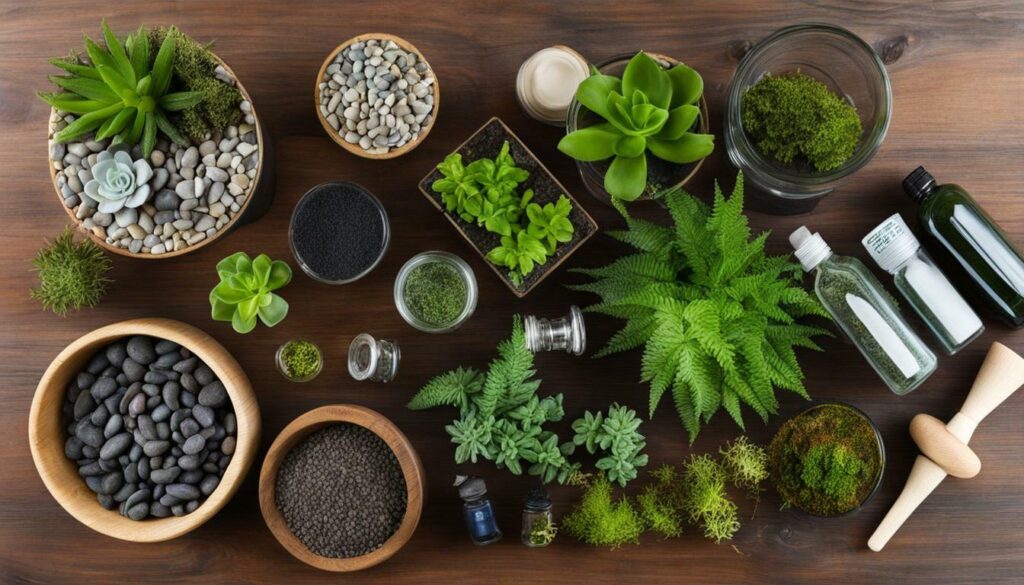
If creating your own closed terrarium seems overwhelming, there are several convenient options available, including ready-made closed terrariums for sale online or purchasing terrarium kits that provide all the necessary materials.
Ready-made closed terrariums can be found on websites like Etsy, where you’ll discover a variety of beautifully crafted designs to choose from. These closed terrariums are already assembled and can be delivered straight to your door, ready to brighten up any space in your home or office.
If you prefer a more hands-on approach, terrarium kits are a fantastic option. These kits come with everything you need to create your own closed terrarium, including a suitable glass container, drainage materials, substrate, and even the plants. With step-by-step instructions included, it’s an enjoyable and educational experience to build your very own miniature ecosystem.
By opting for ready-made closed terrariums or purchasing terrarium kits, you can skip the hassle of gathering all the necessary materials and focus on enjoying the beauty and benefits of these captivating mini ecosystems.
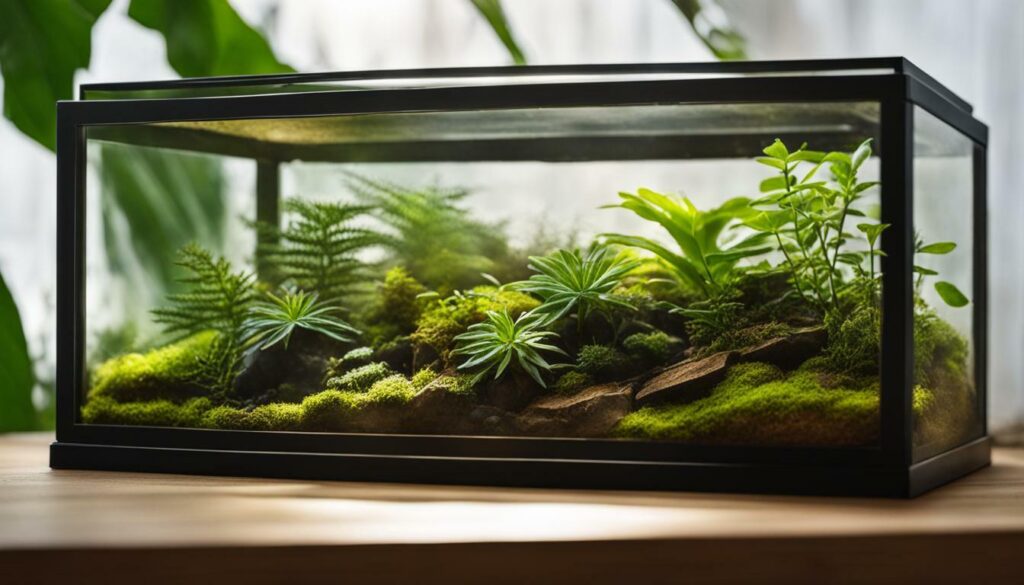
| Pros of Ready-Made Closed Terrariums | Pros of Terrarium Kits |
|---|---|
|
|
Caring for Your Closed Terrarium
Proper care is essential for the long-term success of a closed terrarium, and this involves maintaining a delicate moisture balance, placing it in the right location, and addressing watering and cleanliness requirements. A closed terrarium creates its own self-contained ecosystem, but it still requires some attention to thrive. Here are some key factors to consider when caring for your closed terrarium:
Maintaining Moisture Balance
A closed terrarium relies on a balance of moisture and humidity to sustain its mini ecosystem. It’s important to monitor the terrarium’s moisture levels and occasionally open the lid to allow excess water vapor to evaporate. This helps prevent the growth of mold or excessive moisture that can harm the plants. If the terrarium consistently appears too dry, you can mist it with water to increase humidity. Conversely, if condensation forms on the container walls, it’s a sign of excess moisture, and the terrarium should be left open until the condensation evaporates.
Choosing the Right Location
Placing your closed terrarium in the right location is crucial for its overall health. It should be positioned in a spot with indirect sunlight to provide the plants with the necessary light without overheating the glass container. Avoid placing the terrarium in direct sunlight or near heat sources, as this can cause the temperature inside the terrarium to rise too high, leading to plant damage. Additionally, extreme temperature fluctuations should be avoided, as they can disrupt the delicate balance of the terrarium ecosystem.
Watering and Cleanliness
When it comes to watering, a closed terrarium requires minimal intervention. The enclosed environment creates its own water cycle, with condensation forming on the container walls and then trickling back down to the plants. As a general rule, if the terrarium is well-established and the plants are healthy, additional watering is not necessary. However, if signs of dehydration, such as wilted or yellowing leaves, are observed, you can add a small amount of water to the substrate layer using a dropper or spray bottle. It’s important to avoid overwatering, as excessive moisture can lead to root rot.
Regular maintenance is essential to keep your closed terrarium in top condition. Remove any dead or yellowed leaves promptly, as they can become a breeding ground for bacteria or pests. Cleaning the glass container periodically with a soft cloth or sponge will help to prevent the buildup of dirt or algae. By following these care guidelines, you can ensure that your closed terrarium remains a thriving and captivating mini ecosystem.
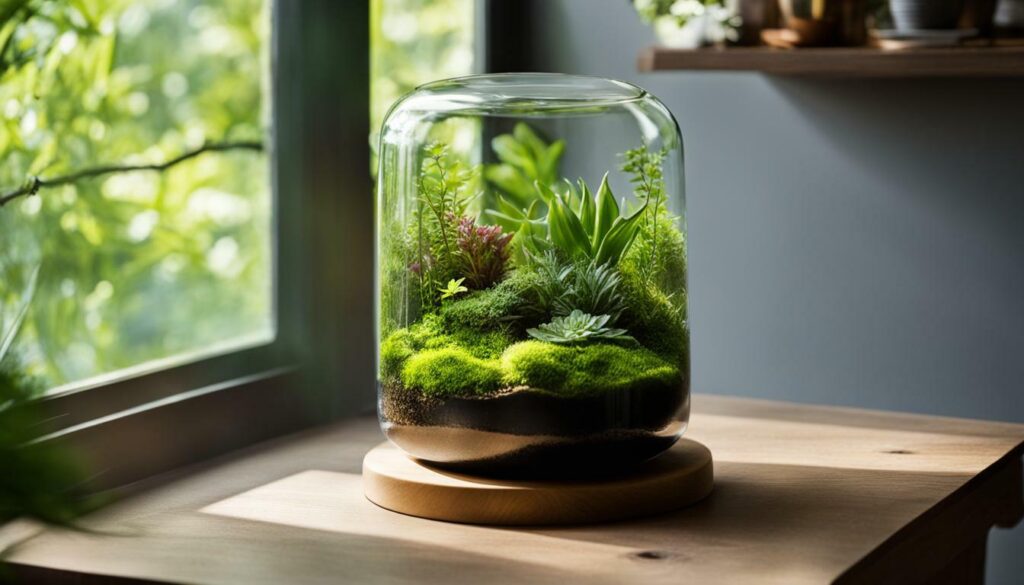
| Key Care Tips for Closed Terrariums: | Key Care Tips for Closed Terrariums: |
|---|---|
| Maintain a delicate moisture balance by occasionally opening the lid to allow excess water vapor to evaporate. | Place the closed terrarium in a spot with indirect sunlight to provide sufficient light without overheating the glass container. |
| Avoid overwatering and only add moisture if signs of dehydration, such as wilted or yellowing leaves, are observed. | Regularly remove any dead or yellowed leaves to prevent the buildup of bacteria or pests. |
| Ensure the glass container is kept clean by periodically wiping it with a soft cloth or sponge. | Avoid placing the closed terrarium in direct sunlight or near heat sources to prevent temperature extremes. |
Suitable Plants for Closed Terrariums
Closed terrariums offer a perfect environment for a variety of plants, and some excellent choices include moss, ferns, foliage plants, and epiphytes. These plants thrive in the humid and moisture-rich conditions created within a closed terrarium, making them ideal for this unique miniature ecosystem.
Moss is a common and popular choice for closed terrariums due to its ability to retain moisture and add a lush green carpet-like covering. It creates a natural, forest-like atmosphere and is often used as a base layer or groundcover. Ferns are another great option as they thrive in high humidity and low light conditions. Their delicate, feathery fronds create an enchanting and tranquil appearance.
Foliage plants, such as Fittonia, Peperomia, and Pilea, are known for their vibrant and striking foliage. They add a splash of color and visual interest to the closed terrarium, enhancing its aesthetic appeal. Epiphytes, including air plants (Tillandsia) and orchids, are unique plants that don’t require soil to grow. They attach themselves to rocks or other surfaces, drawing nutrients and moisture from the air, making them an intriguing addition to any closed terrarium.
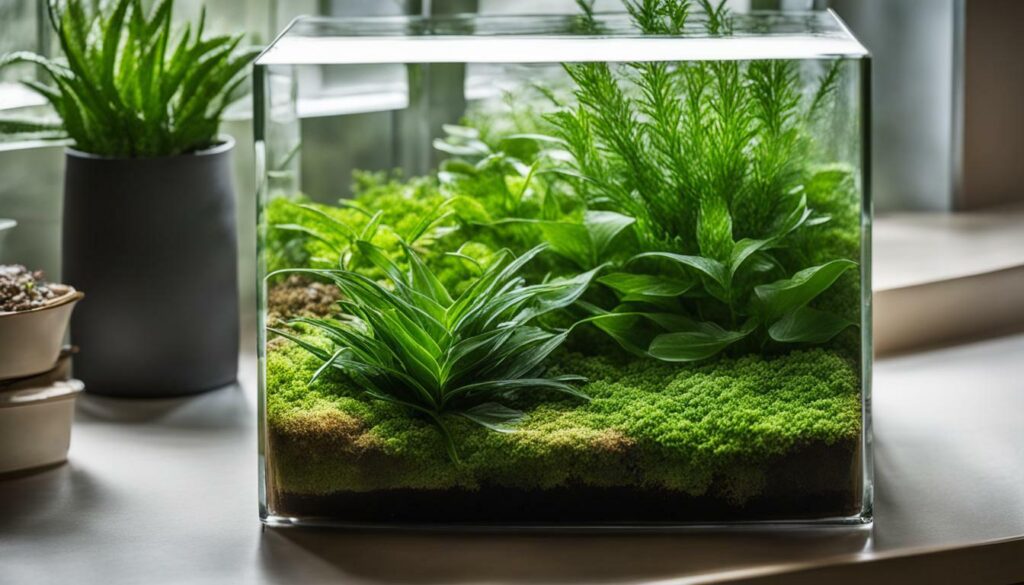
When selecting plants for your closed terrarium, it’s essential to consider their growth habits and light requirements. Choose plants that are compact and slow-growing to prevent overcrowding and the need for frequent trimming. Additionally, opt for plants that prefer low to medium light levels as direct sunlight can create excessive heat and damage the delicate ecosystem.
By carefully choosing suitable plants, you can create a lush and captivating closed terrarium that brings the beauty of nature into your home or office. Experiment with different plant combinations and arrangements to create a visually stunning and self-sustaining mini ecosystem.
Conclusion
Closed terrariums are captivating mini ecosystems that provide an opportunity to observe nature’s cycles on a small scale, creating a self-sustaining and visually pleasing addition to any indoor space. These miniature worlds in glass containers recreate the natural cycles of the world, trapping moisture and humidity to create a thriving environment. While airtight containers are not necessary, it’s important for the terrarium to be able to retain moisture.
When it comes to selecting the right container for a closed terrarium, there are plenty of options available. From apothecary jars to spice jars and even fish tanks, the possibilities are varied in terms of size and shape. Whatever container is chosen, it should be able to showcase the layers that make up a closed terrarium. The key layers include the drainage layer, substrate layer, hardscape, closed terrarium plants, and personal touches to add beauty and character.
Choosing the right plants for a closed terrarium is crucial for its success. Opt for small plants that thrive in a moist environment and have similar light requirements. Think of moss, ferns, foliage plants, and epiphytes to create a lush and visually appealing terrarium. Building a self-sustaining closed terrarium requires careful consideration of factors, such as plant size, appropriate terrarium lighting, and the possibility of introducing beneficial bugs and microfauna.
To create a closed terrarium, the necessary supplies are a clear glass container, drainage materials, substrate, tools, bioactive bugs, plants, and a lid to retain moisture. These supplies can be gathered individually or purchased as part of a ready-made terrarium kit. Platforms like Etsy offer a wide range of options for those looking to bring a closed terrarium into their home.
Caring for a closed terrarium involves maintaining a moisture balance, placing it in a bright spot with indirect sunlight, away from direct heat sources, and avoiding overwatering. The self-sustaining nature of a closed terrarium means that, once established, it can go without additional watering for weeks to months at a time. Regularly removing any dead or yellowed leaves and keeping the terrarium clean will help maintain its beauty and longevity.
In summary, closed terrariums are a fascinating way to bring nature indoors, allowing for a glimpse into the intricate cycles of the natural world. With the right container, suitable plants, and proper care, these mini ecosystems can thrive and provide endless enjoyment for nature enthusiasts and those seeking a unique and visually appealing addition to their living spaces.
What are the key differences between closed terrariums and aquatic terrariums?
Closed terrariums and aquatic terrariums have distinct differences. While closed terrariums are self-sustaining ecosystems enclosed in a glass container, aquatic terrariums require regular aquatic terrarium setup maintenance to ensure the health of the plants and animals in the water. The key lies in the type of environment and care required.
FAQ
What is a closed terrarium?
A closed terrarium is a miniature ecosystem in a glass container that recreates the natural cycles of the world. It traps moisture and humidity, but doesn’t necessarily have to be airtight.
What containers are suitable for a closed terrarium?
Suitable containers for closed terrariums can be found in various shapes and sizes, such as apothecary jars, spice jars, and fish tanks.
What are the key layers in a closed terrarium?
The key layers in a closed terrarium include the drainage layer, substrate layer, hardscape, closed terrarium plants, and personal touches.
How do I choose plants for a closed terrarium?
When choosing plants for a closed terrarium, it’s important to select small plants that can thrive in a moist environment and have similar light requirements.
How can I build a self-sustaining closed terrarium?
Building a self-sustaining closed terrarium involves considering factors like plant size, terrarium lighting, and the possibility of going bioactive with beneficial bugs and microfauna.
What supplies do I need for a closed terrarium?
Necessary supplies for a closed terrarium include a clear glass container, drainage materials, substrate, tools, bioactive bugs, plants, and a lid.
Where can I find closed terrariums or terrarium kits?
Ready-made terrariums can be found for sale on websites like Etsy, or a closed terrarium kit can be purchased that includes all the necessary materials.
How do I care for a closed terrarium?
The key to caring for a closed terrarium is to maintain a moisture balance by occasionally opening the lid to allow excess water vapor to evaporate. It should be placed in a bright spot with indirect sunlight and away from direct heat sources. No fertilizer is needed, and if the ecosystem is well-established, the terrarium can go without additional watering for weeks to months at a time. Regularly remove any dead or yellowed leaves and keep the terrarium clean.
What plants are suitable for a closed terrarium?
Plants suitable for a closed terrarium include moss, ferns, foliage plants, and epiphytes.

